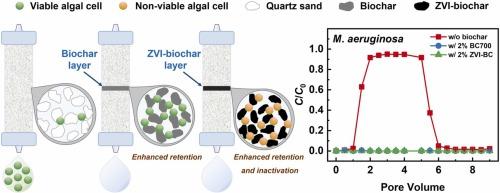生物炭/零价铁生物炭对砂滤系统的改造,以同时去除藻类细胞和微囊藻毒素lr
IF 11.3
1区 环境科学与生态学
Q1 ENGINEERING, ENVIRONMENTAL
引用次数: 0
摘要
高密度的藻细胞和有害藻华期间释放的藻毒素不能被传统的砂过滤系统有效地去除。在本研究中,裸砂过滤柱通过不同质量比的生物炭(在不同热解温度下合成)进行修饰,并用于同时从水中捕获藻类细胞和微囊藻毒素。我们发现,加入700℃合成的2 wt%生物炭,在慢速和快速过滤条件下均能有效去除铜绿微囊藻和寻常小球藻细胞,并能去除悬浮液中释放的微囊藻毒素- lr。生物炭改性过滤系统在实际水样中,经过3个输送-洗脱循环,连续运行50个孔体积,也实现了天然有机物共存的有效去除效果。皱褶结构对藻类的高吸附能力和生物炭的负电荷较少有助于提高去除性能。此外,利用零价铁(ZVI)负载生物炭修饰砂柱可以有效地灭活和抑制保留的藻类细胞的再生。结果表明,生物炭/ zvi -生物炭作为一种廉价易得的生物材料,可用于改造砂滤系统,有效去除水中的藻类细胞和毒素。本文章由计算机程序翻译,如有差异,请以英文原文为准。

Modification of sand filtration system with biochar/zero valent iron-biochar for the simultaneous removal of algal cells and microcystin-LR
High-density algal cells and the released algal toxins during harmful algal blooms cannot be effectively removed by traditional sand filtration systems. In this study, bare sand filtration columns were modified by different mass ratios of biochar (synthesized at different pyrolysis temperatures) and used to simultaneously capture algal cells and microcystins from water. We found that the addition of 2 wt% biochar synthesized at 700℃ could effectively remove Microcystis aeruginosa and Chlorella vulgaris cells under both slow and fast filtration flow conditions, and remove the released microcystin-LR in suspension. Effective removal performance with the coexistence of natural organic matters, in real water samples, during 3 transport-elution cycles and continuous operation for 50 pore volumes was also achieved by biochar-modified filtration system. The high algal adsorption capacity due to the wrinkled structure and the less negative charge of biochar contributed to the enhanced removal performance. Moreover, using zero valent iron (ZVI) loaded biochar to modify sand columns would effectively inactivate and inhibit the regrowth of retained algal cells. The results showed that as one type of inexpensive and readily available bio-materials, biochar/ZVI-biochar could be used to modify the sand filtration system for the effective removal of algal cells and toxins from water.
求助全文
通过发布文献求助,成功后即可免费获取论文全文。
去求助
来源期刊

Journal of Hazardous Materials
工程技术-工程:环境
CiteScore
25.40
自引率
5.90%
发文量
3059
审稿时长
58 days
期刊介绍:
The Journal of Hazardous Materials serves as a global platform for promoting cutting-edge research in the field of Environmental Science and Engineering. Our publication features a wide range of articles, including full-length research papers, review articles, and perspectives, with the aim of enhancing our understanding of the dangers and risks associated with various materials concerning public health and the environment. It is important to note that the term "environmental contaminants" refers specifically to substances that pose hazardous effects through contamination, while excluding those that do not have such impacts on the environment or human health. Moreover, we emphasize the distinction between wastes and hazardous materials in order to provide further clarity on the scope of the journal. We have a keen interest in exploring specific compounds and microbial agents that have adverse effects on the environment.
 求助内容:
求助内容: 应助结果提醒方式:
应助结果提醒方式:


